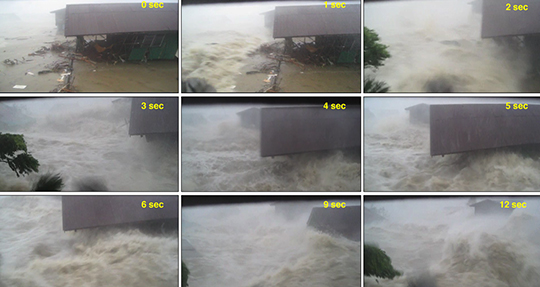
Typhoon Haiyan's Destructive Tsunami-like Wave Generated by Surf Beat over a Coral Reef

Tsunami-like surf beat destroying the village of Hernani, Eastern Samar, the Philippines, during Typhoon Haiyan. Snapshots taken from a video recorded by Nixon Gensis. Roeber & Bricker (Nature Communications, 2015) Images used with permission of Plan International.
Researchers from the International Research Institute of Disaster Science (IRIDeS) at Tohoku University in Sendai, Japan, have been looking into how tsunami-type waves can originate from massive storm systems, independent of earthquakes or landslides.
According to Volker Roeber and Jeremy D. Bricker, massive storm systems can be the cause of devastating tsunami-type waves. It happened during Typhoon Haiyan, which struck the Philippines in November 2013. Typhoon Haiyan was one of the strongest typhoons ever recorded, causing more than 6,000 casualties.
A development aid worker caught a scene on video where a wave devastated parts of a small fishing village (see Fig. 1). The wave swept away entire houses and was reminiscent of the tsunami waves that followed the Great East Japan Earthquake in 2011.
Roeber and Bricker have investigated the generation and characteristics of this phenomenon and have found a surprisingly simple explanation called “surf beat.”
As waves travel in the open ocean, their wavelength determines the propagation speed. Longer waves overtake shorter ones and the superposition of multiple waves leads to the formation of wave groups, often referred to as “sets.” The wave groups can be considered as an additional long wave component embedded in the sea state and bound by the storm waves.
Offshore of the wave breaking zone, the long wave component is not directly visible because it is very long and superimposed by other short waves. “The long group waves can have wavelengths of several kilometers but their height is much lower than that of the individual storm waves. This is similar to what characterizes nearshore tsunamis,” explains Roeber.
As the wave groups approach shallow areas, they break and transport water onshore. Consequently, the accumulated water level pulsates with the wave groups. This is what's called the “surf beat” and it can be observed at many beaches worldwide.
While a surf beat is usually harmless and goes unnoticed, it had a devastating impact on the town of Hernani during Typhoon Haiyan. What's more surprising is that Hernani is located behind a 0.5 km wide fringing reef, which should have protected it. “Until now, we have believed that reefs serve as a reliable protection from storm waves”, says Bricker. “But during Haiyan, the opposite seemed to have happened.”
It turned out that the steep slope of the reef that leads towards the open ocean allows for only a very short wave-breaking zone. When waves break, they dissipate energy. But over the steep reef slope, the breaking process affected mostly the short storm waves.
In contrast, the long group waves, which form the surf beat, were able to keep almost all of their energy. These waves propagated freely over the reef flat and even steepened at the beach into a turbulent breaking wave, which destroyed the town's seawall and many houses behind it.
“We computed this tsunami-like wave with our numerical models and found its energy to be very similar to waves from past tsunamis in the Pacific,” says Roeber.
In addition, the researchers state that the Hernani wave was not a worst-case scenario. If the period of the group waves had been in sync with the natural oscillation period of the fringing reef, the wave would have amplified due to resonance and could have been even more destructive. This scenario would have occurred if the reef had been about half as wide.
As Typhoon Haiyan showed, tropical storms not only cause devastation due to strong winds. In coastal areas they also cause flooding from storm surges.
A storm surge is an abnormal increase in the local sea level. It is mainly driven by the wind – which pushes water landward – and the low pressure of the storm that causes the water to arch like a convex lens. A storm surge can flood low-lying coastal areas similar to an extremely high tide level.
In general, disaster management agencies determine coastal flood hazard zones based on studying the storm surge inundation. In most countries, this is currently done by using computer models. However, the conventional storm surge models neglect the important dynamics of the individual storm waves, which is a plausible explanation for the destruction at Hernani.
“The storm surge models do a great job for what they were designed for, but they simply cannot account for the phenomena such as what we have seen in Hernani,” says Bricker. Both researchers therefore think that it is necessary to additionally utilize a new generation of models that resolve individual waves for hazard mitigation purposes.
“We have developed accurate and powerful numerical tools which are able to compute these dangerous tsunami-type waves,” says Roeber. He especially recommends that the flood maps for coastal communities sheltered by fringing reefs should be re-assessed. This includes many islands in the tropical and sub-tropical latitudes that have experienced strong storms in the past, such as Okinawa and Hawaii.
“Tsunami-like waves such as the one in Hernani will happen again,” he says. “But we now can be better prepared.”
Contact details:
Volker Roeber
International Research Institute of Disaster Science, Tohoku University
Tel: +81-22-752-2088
Email: roeberirides.tohoku.ac.jp
Jeremy D. Bricker
International Research Institute of Disaster Science, Tohoku University
Tel: +81-22-752-2088
Email: brickerirides.tohoku.ac.jp
Associated links
Tohoku University press release
Watch the original video from here












